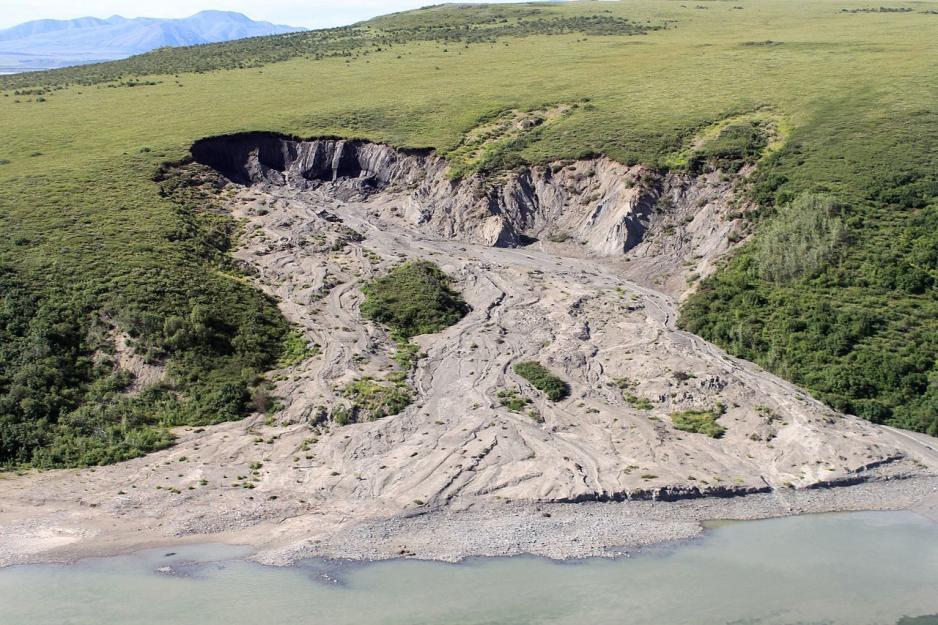For Arctic Nitrous Oxide Emissions, A Little Goes a Long Way

A warming Arctic is releasing potent greenhouse gases like nitrous oxide into the atmosphere that contribute to global warming, exposing gaps in what we know about thawing permafrost.
Nitrous oxide may not be the first gas to come to mind when you think about climate change. In fact, you may not have even realized it’s a greenhouse gas to put on your list of things to worry about. While nitrous oxide, N2O, may not be as famous as carbon or methane emissions, the implications of its release into Earth’s atmosphere from melting permafrost are no less frightening.
N2O as a driver of climate change has 300 times the warming potential of carbon dioxide over a hundred-year time span. A new report in nitrous oxide emissions from Arctic peatlands following permafrost thaw from the University of Eastern Finland estimates that more than 67 billion tons of nitrogen stocks are stored in the upper three meters of permafrost soil. Arctic nitrogen has been both build up through thousands of years through the nitrogen cycle and recently augmented by this mineralized nitrogen interacting with microbes to produce new nitrous oxide.
Despite the potential dangers of N2O release from thawing permafrost, little is known about the greenhouse gas in the circumpolar north.
A Black Hole in Arctic Climate Change Research
"The main reason for the scarcity of N2O data is the current lack of awareness of N2O emissions from Arctic soils" explains Carolina Voigt to High North News. Ms. Voigt is a researcher at the Department of Environmental and Biological Sciences at the University of Eastern Finland and the lead of the research project, the findings of which were published in the Proceedings of the National Academies of Sciences this month. "N2O production in Arctic soils was, until recently, believed to be negligible, mainly due to the low nitrogen mineralization rates in the cold climate. This makes nitrogen a limiting factor for many biological processes in the North, also for N2O production. Also, N2O emissions are a rather patchy phenomenon: low emissions are tricky to measure, and sensitive, advanced instruments are required, whereas high emitting sites are scattered across the Arctic."
But Voigt argues that more emphasis should be put on studying N2O emissions in the Arctic, and the regional nitrogen cycle more generally. "We have identified some of the potential N2O "hot spot" areas, and among them permafrost peatlands stand out due to their large soil organic matter stocks that, besides carbon, include also a lot of nitrogen."
Leaving Nothing to Chance: Thawing Permafrost in a Lab
To study the release of N2O, the research group developed a novel approach to study the direct effect of permafrost thaw on greenhouse gas dynamics without getting a mixed signal from other system dynamics in soil warming and moisture changes – a difficult feat to achieve in the field where these factors usually coincide.
"For the study, we collected large and intact peat profiles, including vegetation reaching all the way from the surface down to the upper permafrost," Maija Marushchak explained, a postdoctoral researcher at UEF and second author on the publication. "We froze these so-called mesocosms immediately to mild freezing temperatures and took them to a climate-controlled chamber. The mesocosms were kept under stable temperature, but thawed step-wise from top to the bottom." In each step of the thaw, Marushchak, Voigt, and their 9 team makes were able to monitor the N2O emissions and different nitrogen and carbon pools along the peat profile. "After reaching the permafrost part," Marushchak continued, "we could see a clear signal of increased N2O emissions in dry mesocosms, while wet mesocosms with high water level did not show similar post-thaw peak."
Another benefit of the UEF team’s approach is taking a sample form the full soil system, including vegetation. "Most lab experiments studying greenhouse gas release from permafrost use individual soil samples taken at different parts of the soil profile," according to Marushchak. "By doing this, they ignore plant-soil interactions and transformations that happen when gases migrate through the soil profile. These important processes were accounted for in our experiment."
Carbon and Methane, Make Room for Nitrous Oxide
The new study shows that N2O is yet another mechanism for how permafrost thaw could amplify global warming – but more still needs to be done. "In order to verify and improve our knowledge on N2O emissions from soils several steps are needed," notes Marushchak, looking forward to future research. "First," she begins, "we need to extent the N2O measurement network to a larger number of sites across the pan-arctic. The long-term goal of establishing such an N2O measurement network would be to determine a pan-Arctic N2O budget." Researchers also need to improve estimates on pan-Arctic soil nitrogen stocks and learn more about the small-scale process of microbes in the Arctic’s nitrogen cycle.
"With time," Marushchak hopes, "the new knowledge on what controls the production and emissions of greenhouse gases from permafrost soils will be incorporated into process models that are used to predict the interactions between arctic ecosystems and climate. This will allow better estimation on how much permafrost warming could amplify climate change."
"The take-away message of our article to the readers would be that not only CO2 and CH4, but also N2O needs to be considered in research on climate feedbacks from Arctic ecosystems," adds Voigt. "N2O is a strong greenhouse gas, around 300 times more powerful than CO2 in warming the climate per mass unit. Permafrost soils contain a huge amount of organic nitrogen, not only carbon, that could be mobilized with warming and thaw. We believe that N2O plays a bigger role than currently acknowledged, especially in a future warmer world, when permafrost soils are thawing."
Regions across the north are already seeing the frozen ground thaw from warmer temperatures, a process that, according to Marushchak, "is impossible to stop by human actions if the temperatures keep rising."
